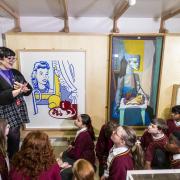Rambert continue their long standing association with the Lowry with its first full length narrative dance work for over 30 years.

It must be a long time since Rambert performed a full-length piece on their major tour, rather than a triple bill, so Kim Brandstrup’s new work (it was premiered in London earlier this year) is an ambitious and welcome departure.
I guess the reason we so often see triple bills is that contemporary dance lends itself to abstract concepts, or at least short and simple narratives, rather than detailed extended stories that can hold your interest through an interval and make you keep wanting more.
Here the story is based (loosely) on a play about a prince who’s been imprisoned all his life being freed for a day – once liberated, he experiences the dark side of life but is re-imprisoned and told that all his experiences were a dream. When he gets out a second time he sees the world very differently.
What we see is a man asleep in a cold, grim institutional space, and dreaming from the start: his dreams are repeatedly of someone being liberated by the touch of a young woman and of different characters all longing for another world outside their ‘imprisonment’.
In the second part the sets are literally turned around, so he’s on the outside and experiences that other world as a real girl wakes him. And the ‘real’ world is a scary place – in the end he finds some kind of peace and affection, but only by returning to the prison.
It’s Plato’s Cave, isn’t it (though I didn’t see a credit for the old Greek guy in the programme)? We’re all ‘imprisoned’ by our perceptions – seeing shadows and distortions of something out there, unable to come to terms with real reality if we do encounter it and having to settle for the limitations of the human condition. In the first part there are even flickering headlights coming through the windows and sounds from an outside world (imaginative contributions from the design team led by the Quay Brothers).
But this is contemporary dance, and you have to imagine your own narrative from choreography that’s often form-led – beautifully so, with a graceful modern-ballet language of solo, duo and ensemble movement – but without mime or overt incident.
What I got from it was that the dream showed ‘princes’ and two ‘maidens’ longing to escape their prison, their conflict and distress as they and their fellows realise they can’t, and an independent female who yearns for the same thing. In the second half the women of the outside world turn into dancing dementors over whom the liberated one has no control, but eventually he finds a glimmer of fulfilment in a lovely, long duet. (There’s also a kind of comic interlude in which he duets with his doppelgänger, rather like Peter Pan and his shadow, but I couldn’t see the point of that).
The score – played live by a very good orchestra conducted by Christopher Austin – is all from Lutos?awski: it makes good theatre music, with its range of atmosphere and deft capture of moments of despair, absurdity and joy, but (as with all dance created to existing finished concert works) requires its own time-frames to be filled out rather than being determined by the dance narrative.
The quality of the dancing itself is superb – from Rambert we expect nothing less – and the sheer visual delight of it all makes for a fascinating evening.



























